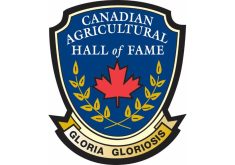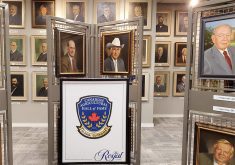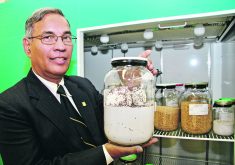Johanne Ross inducted into Canadian Agricultural Hall of Fame for her work on ag education and literacy
Last year, Agriculture in the Classroom Canada and its provincial organizations connected more than two million students to stories and information about food and farming.
That’s a decent number, seeing how COVID-19 disrupted a few things in 2020.
It’s also a testament to the determination of Johanne Ross, the executive director of Ag in the Classroom Canada (AITC–Canada).
For 21 years, Ross has advocated for agricultural education and made millions of kids aware that their container of chocolate milk, or the carrots in the corner of their plate, came from a farm somewhere in Canada.
Read Also

Fuel rebate rule change will affect taxes and AgriStability
The federal government recently announced updates to the fuel rebates that farmers have been receiving since 2019-20.
Her two decades of work, ingenuity and dedication were recognized Nov. 21 at a ceremony in Winnipeg, when Ross was inducted into the Canadian Agricultural Hall of Fame.
Ross, from Minnedosa, Man., was one of five inductees to the Hall in 2021. Joining her is Gordon Bacon, long-time leader in Canada’s pulse sector, agricultural lawyer Don Buckingham, Stan Eby, an Ontario cattle producer and former chair of the Canadian Cattlemen’s Association and Dr. Phil Williams, a cereal chemist who worked 40 years at the Canadian Grain Commission’s Grain Research Laboratory in Winnipeg.
Ross’s journey to the Ag Hall of Fame began in 2000, when she was looking for work.
Her two boys were old enough to attend school and Ross wanted to return to the workforce. But Ross wanted something different than she did before she had kids — in the crop input and feed business.
While looking, she came across a job ad for Ag in the Classroom Manitoba.
“I’d never heard of them. It really piqued my interest to find out what they were,” she said, adding she was curious because she had considered becoming a teacher, before choosing to study agriculture at the University of Manitoba.
“(It sounded) like something I would love because… (it) is a neat way to combine my other interest in education.”
She took the position and within months, Ross changed how Canadian kids learn about agriculture. Before she arrived Ag in the Classroom Manitoba would create educational resources and share the information with teachers, to use in their classrooms.
“You’d send it out, but you weren’t sure if it was being used or gathering dust,” she said in 2012.
Ross realized that students needed a more direct link to agriculture.
Farmers and people in the ag industry needed to be in the classroom, talking about what they do and why they love their job.
“That’s the foundation of our success. Telling the stories of the real people in agriculture,” said Ross, who recruited volunteers and partners in the ag sector to visit schools across Manitoba.
Having a farmer, veterinarian or crop scientist in the classroom, rather than a worksheet about food and farming, made all the difference for Ag in the Classroom Manitoba.
“You see the students light up when they make these connections…. The food on their plate and how it actually got there. (Because) they’re not usually thinking much past the grocery store,” Ross said.
“And even being thanked. For example, a dairy farmer getting a hug from a Grade 5 student for getting up early to milk the cows, so they could have chocolate milk.”
Ross also developed events, like the Amazing Agriculture Adventure, where Grades 4 and 5 kids move through stations and get a hands-on experience about food and farming.
In 2015, Ross became the inaugural leader of a new organization; Ag in the Classroom Canada. The group partners with 10 provincial organizations to deliver and promote agricultural education.
Thanks in part to Ross’s leadership, Ag in the Classroom Canada has attracted the financial support of government and global companies, including Bayer, Corteva, Cargill, RBC, Richardson International and BASF.
“It is absolutely essential that young Canadians understand where their food comes from,” said federal agriculture minister Marie-Claude Bibeau in March when announcing $1.6 million in funding for Ag in the Classroom. “They must know what farmers’ work consists of and how hard they work to take care of their animals and our environment in order to provide us with high-quality food.”
While Ag in the Classroom Canada is a success, last year the organization identified long-term goals to set out what it was trying to accomplish.
The answer was ag literacy.
“What it really is about, is graduating Grade 12 students in Canada so that they are agricultural literate after that Kindergarten to Grade 12 journey,” Ross said.
Building a population of Canadians with a basic knowledge of farming and food could take time. Possibly a decade or more.
“It’s a long game. And it is going to take a while to make that big difference,” Ross said.
“But reaching two million students last year was pretty monumental. So maybe it will happen sooner than we think.”
Ag Hall of Fame welcomes new members
The Canadian Agricultural Hall of Fame inducted nine new members at a ceremony in Winnipeg: four for 2020 and five for 2021. There was no official ceremony for new inductees last year due to COVID-19. They are:
- Jay Bradshaw, an agribusiness leader and and advocate for advancing modern agricultural technology who lives in Guelph, Ont.
- James Halford, who pioneered zero tillage farming on the Prairies and invented the ConservaPak seeder. He lives in Indian Head, Sask.
- Bryan Harvey, who developed more than 60 varieties of barley throughout his 50-year research career. He lives in Saskatoon.
- Douglas Hedley worked with Agriculture Canada, where he became a leading expert on Canadian agricultural policy. He lives in Nepean, Ont.
- Gordon Bacon, the long-time head of Pulse Canada, lives in Winnipeg.
- Don Buckingham, who built a strong legal structure for the complex Canadian agri-food system, lives in Ottawa.
- Stan Eby, an Ontario beef farmer and long-time beef industry leader, lives near Kincardine, Ont.
- Johanne Ross, who worked to bring agricultural education into classrooms across Canada as executive director of Agriculture in the Classroom-Canada, lives near Minnedosa, Man.
- Phil Williams, an internationally rec- ognized pioneer in near infrared spec- troscopy (NIRS) technology, lives in Nanaimo, B.C.
















